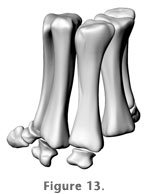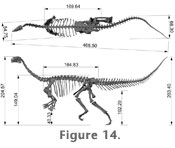| |
BENEFITS AND LIMITATIONS OF MECHANICALLY DIGITIZED DATA
The obvious benefit of digital data is the ease with which it can be copied, shared and stored, and compared to real bones and casts. Mechanical digitizing data has smaller file sizes than unreduced CT or laser scan based data, and is, therefore, even easier to email, upload, or use in a CAD software.
D ue to the sizes and weights involved, manipulation of real bones, especially sauropod bones, to ascertain joint mobility, is problematic even with only two elements. Trying to manually sort together partial skeletons such as a sauropod manus without sandbags or extensive custom-cut styrofoam supports is impossible. Digital files, on the other hand, can easily be used for this purpose, e.g., in Rhinoceros® (see
Figure 13, digitally mounted hand of Giraffatitan (Brachiosaurus) brancai [MB.R.2249 R9 through R17] and
Wilhite 2003a,
2003b, and
2005;
Mallison 2007) or other CAD programs (e.g.,
Allen 2008). Paper drawings also work well, but are limited to two dimensions, while digital data can be freely rotated, sectioned, and rearranged as desired.
Figure 14 shows a CAD mount of a complete Plateosaurus skeleton as it could be posed in a museum mount. Here, the correct articulation of a large number of elements can be checked easily, and exact measurements from all dimensions can be taken with a mouse click before any work is done with the real bones. ue to the sizes and weights involved, manipulation of real bones, especially sauropod bones, to ascertain joint mobility, is problematic even with only two elements. Trying to manually sort together partial skeletons such as a sauropod manus without sandbags or extensive custom-cut styrofoam supports is impossible. Digital files, on the other hand, can easily be used for this purpose, e.g., in Rhinoceros® (see
Figure 13, digitally mounted hand of Giraffatitan (Brachiosaurus) brancai [MB.R.2249 R9 through R17] and
Wilhite 2003a,
2003b, and
2005;
Mallison 2007) or other CAD programs (e.g.,
Allen 2008). Paper drawings also work well, but are limited to two dimensions, while digital data can be freely rotated, sectioned, and rearranged as desired.
Figure 14 shows a CAD mount of a complete Plateosaurus skeleton as it could be posed in a museum mount. Here, the correct articulation of a large number of elements can be checked easily, and exact measurements from all dimensions can be taken with a mouse click before any work is done with the real bones. Exhibit design and arrangement can be accurately planned and altered easily at any time. While the Plateosaurus skeleton in
Figure 14 is derived from CT data, the same work could also be done using NURBS bodies from mechanical digitizing. Exhibit design and arrangement can be accurately planned and altered easily at any time. While the Plateosaurus skeleton in
Figure 14 is derived from CT data, the same work could also be done using NURBS bodies from mechanical digitizing.
Sharing data with researchers abroad can be problematic with conventional methods, too. Either expensive travels are required, or casts or originals must be shipped at great cost. Digital files can be sent via email or on CDs/DVDs instead, given sufficient resolution for the planned project. They also do not require storage room, in contrast to casts.
Digital files can also be accurately and quickly scaled to produce proportionally correct composite skeletons, while physical scale models must be molded by hand, a process that requires considerable time and resources. Skeleton drawings of the type made famous by the work of
Paul (1987,
1996,
1997,
2003) usually also include only two dimensions – the width of the animal is not indicated. Even if a top view or a cross section drawing is available (Leahy 2003;
Paul 2003), much interpretation is needed. Often the operator has no choice but to guess the third dimension in many places, incurring significant inaccuracies in the model. Sometimes, lateral and cross-section views of the same animal contradict each other (Paul 1987: Plateosaurus engelhardti, see
Mallison 2007). Digital bones, in contrast, allow articulating a digital three-dimensional skeleton. It can be rotated to view it from any aspect, sectioned to facilitate modeling sections otherwise hidden by broader neighboring areas, and has the added benefit compared to measurements that errors become easy to spot. Also, the exact articular surface geometries are depicted, whereas a drawing can hardly detail a sloping or curving surface well.
Digital bones can also be used to produce exact casts of the original bones without subjecting them to molding – a process that may damage the fossils even if great care is taken to minimize the physical stresses exerted. For example, Research Casting International created rapid prototyping copies of the MFN Kentrosaurus mount. These were used instead of the real bones to build the armature for the new mount in order to reduce the risk of damaging the original material. Obviously, specimens must be handled carefully, which is true both for moving them for CT or laser scanning and for mechanical digitizing. Extremely fragile bones are best scanned with touch-free methods and not suited for mechanical digitizing. However, aside from minimal scratches on the surfaces of lacquer-covered specimens, we never damaged any bones during our digitizing.
The biggest limitation of digital data is the lack of detailed representation of surface features and colorations. Also, the smaller the files are the rougher the resolution will be, reducing detail. Hence, for delicate objects, CT data or high resolution laser scans have a clear advantage over mechanical digitizing as described here and by
Wilhite (2003b). Additionally, all research that requires information not encoded in the digital files can only be done by studying the real bones. This problem can be somewhat amended by adding color photographs of surface colors and features to the digital file.
For a detailed discussion of the benefits and problems of digital data, also see
Wilhite (2003a).
|